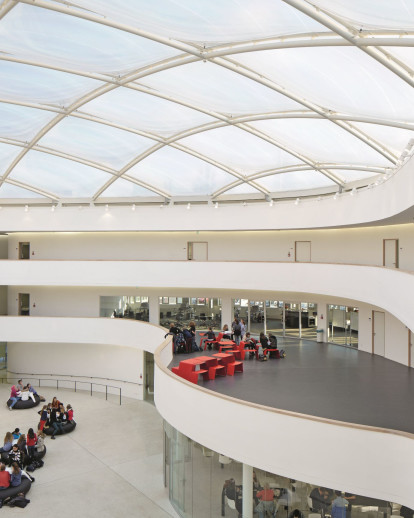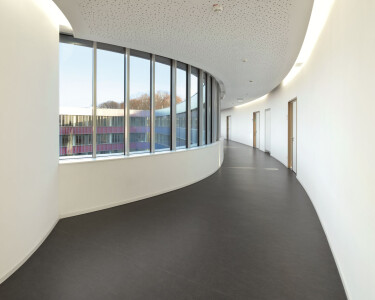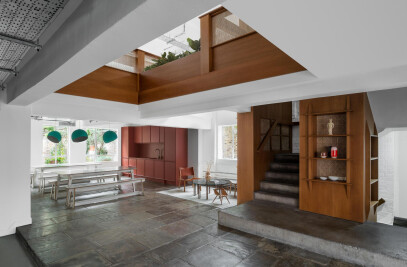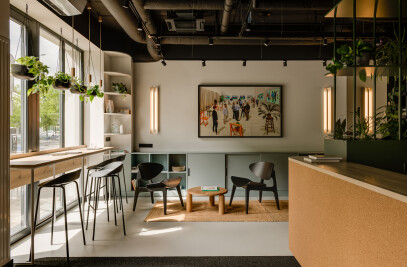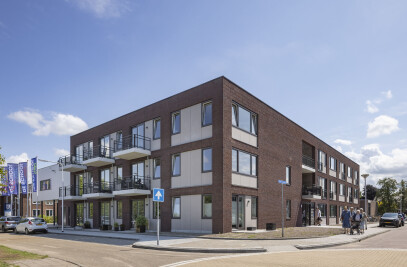“We wanted to avoid a hierarchical structure where the teachers occupy the top floor of the building and the pupils are consigned the lower floors. Instead, we put the teachers and administrative staff in a shared, central ring floor, in the middle of the everyday activities. Around the playful, wider middle part, everyone can see and meet one another.”
| Element | Brand | Product Name |
|---|---|---|
| Manufacturers | Forbo Flooring Systems | |
| Manufacturers | Vector Foiltec | |
| Manufacturers | SCHÜCO | |
| Manufacturers | B.Keusgen-Estrich | |
| Manufacturers | Bauunternehmung Malic | |
| Manufacturers | Bohle Innenausbau Gmbh |
The design of the ‘Neues Gymnasium’ draws directly from the qualities of the surrounding landscape of the geological garden: the distortions of the strata and slopes of the natural monument are continued in the arcing lines of the building so that it blends with the landscape to form a whole suffused with an atmosphere of dynamic tension. As a symbol of the joining of two schools, the new building consists of two interlocking ring-shaped volumes, a ‘communicative’ ring to the west and a ‘concentration’ ring to the east. The more public areas, which are often used outside regular school hours, are arranged around a three-storey atrium in the western ring, while the classrooms are grouped around an interior courtyard in the eastern ring, offering spaces for concentrated study or that connect directly to outdoor areas. On entering the school via a broad glazed entrance in the northwest corner, one passes into the ‘main square’ of the school, a three storey, 12-metre-high atrium that serves as the light-filled, open heart of the school. Gently curving walls, variously bowing ribbon-like balustrades, a spiraling sculptural stair and an arcing terraced floor lend the hall a sense of movement and dynamism. Illuminated from above by a lightweight, translucent, air-cushion membrane roof, the glazed walls and façades of this amorphous central space connect it with its adjacent rooms and outdoor areas. The combination of transparent walls and the open galleries of the floor plan establish numerous visual connections and provides instant orientation – one has a view of the entire interior as soon as one enters the building. Grouped around the ground floor of the communicative atrium are the assembly hall, refectory, school café and ‘Europa room’ which can be joined together as required by removing mobile partitions. The remaining communal areas, such as the self-study center with work and communication zones as well as the school offices and the student council, are arranged on curved open galleries on the first floor of the atrium near to the main entrance. The second floor contains the biology, chemistry and physics labs, which are likewise linked to the entrance hall via open galleries. A broad spiral staircase connects the open galleries with one another allowing them to be used for larger school events, augmenting the activities in the central forum. Arranged at the intersection of the two halves of the floor plan, the stair also links the two rings of the building. The variability of the central atrium makes it an attractive space that can be used for a wide range of school events and is perceived as a communal space for the school. The ability to shape this space – the configuration of spaces can be changed and furniture can be moved around freely – enables staff and students to appropriate it for their needs and helps the children identify with ‘their’ school. In addition, it symbolizes the principle of democratic equality and is as such a spatial manifestation of a cooperative school concept. The classrooms are grouped around an interior courtyard and water basin in the eastern ring of the building. Like the ‘amphitheater’, this peaceful introverted outdoor space augments the other special functions on the ground floor: the activities in the multi-purpose and all-day areas, or the music and art classes can be situated outdoors as required. The regular classrooms for the upper and lower secondary school curriculum are arranged on separate levels on the two upper storeys of the eastern ring. The ability to arrange the interiors flexibly caters for different teaching formats and the use of analogue and electronic blackboards, ‘interactive’ beamers, school laptops and computer workstations facilitates a range of modern teaching methods. At the same time, the school café, ‘Europa room’, self-study center, computer room, play and sports areas, as well as school magazine and school council, promote and support a sense of social commitment and responsibility towards the school: the school becomes a ‘place of learning’, not just in terms of subject matter but also as a place to train social, communicative, methodological and personal competencies. The spatial expression of this concept can be seen in the curving walls of the interior that widen and narrow, opening and closing without beginning or end to form a spatial continuum. Instead of long straight corridors designed to hurriedly convey people towards a specific destination, the spatial configuration of the school encourages relaxed, strolling patterns of movement. The irregularly formed, open galleries and gently arcing steps create opportunities to stop, sit down and talk to one another; the emphasis is not on the result but the process. Like in collaborative lessons, the path is the goal. To strengthen the impression of the organic curved lines of the architecture, the façade is given a strong horizontality. Ribbons of transparent glazing alternate with bands of color while a sun shading fin projects at each floor in rings around the building’s perimeter, emphasizing the dynamic curved form of the new building. In addition to providing good thermal insulation, which contributes to the building’s positive energy balance, the bands of color are a special creation: the artist Ulrich Erben developed a color scheme for the façades that employs three basic colors: red, blue and yellow. These are arranged in the vertical façade modules in such a way that the building’s appearance changes from red to blue as one walks past the building. In addition, the first article of the United Nations – “All human beings are born free and equal in dignity and rights. They are endowed with reason and conscience and should act towards one another in a spirit of brotherhood.” – is inscribed into the façade. In a modern interpretation of classical inscriptions, the letters are formed out of pixelated dots highlighted in yellow in the grid of the façade, and are displayed in three languages – German, English and Latin – each on a horizontal ribbon that runs around the entire building. In the classrooms, the indoor air quality and the accompanying subjective sense of comfort contributes to the pupils’ ability to concentrate and pay attention, and is therefore an essential factor for successful lessons. Thermal insulation to reduce heat loss in winter and overheating in summer in conjunction with a user-oriented heating and cooling system and an automatic fresh air supply system ensures that temperatures remain within the range 20 – 26°C all year round and that the indoor air quality is maintained. The ring-shaped floor plan, in which rooms face predominantly east or west, reduces undesirable solar gain at low angles of incidence, thereby reducing heat gain in summer. A horizontal sun shading fin cantilevers outwards by almost a meter on the south- and southwest-facing facades and shields against overhead sun along with externally-mounted individually adjustable slatted blinds made of aluminium. The facing concrete ceilings, of which 50% are unclad, as well as the water basin in the courtyard of the eastern ring also help cool down the building. The heavy construction elements absorb heat during the day, and give it off again during the night via vents in the façades. The water basin also provides adiabatic cooling through the cooling effect of evaporation and helps create a pleasant microclimate. These various means of reducing solar gain in summer obviate the need for additional mechanical cooling of the classrooms in the summer months. In winter, the shallow incident rays of light can pass unhindered through the extensive glazed surfaces of the façade, providing direct solar gain on the south side that affords a basic level of warmth. In combination with highly effective thermal insulation and an airtight building skin, the thermal heat requirement of the building is kept to a minimum, making it possible to do without a conventional heating system. Instead the necessary warmth for the classrooms is provided by decentralized ventilation units that are integrated in the façade and which also feed the atrium’s underfloor heating system. To ensure good indoor air quality in the classrooms, the supply and exhaust ventilation systems are controlled by sensors that monitor CO2 concentration in the air and automatically control the vents in the façade to provide fresh air as needed. An integral heat recovery system reclaims heat from the exhaust air and uses it to pre-warm the supply air in winter. Photovoltaic modules are installed on the roof as a contemporary addition to the heating and ventilation installations. Through the combination of these various different means, the building has achieved “Green Building” certification and performs more than 25% better than the requirements of the EnEV Energy Saving Ordinance.
Products Behind Projects
Product Spotlight
News

FAAB proposes “green up” solution for Łukasiewicz Research Network Headquarters in Warsaw
Warsaw-based FAAB has developed a “green-up” solution for the construction of Łukasiewic... More

Mole Architects and Invisible Studio complete sustainable, utilitarian building for Forest School Camps
Mole Architects and Invisible Studio have completed “The Big Roof”, a new low-carbon and... More

Key projects by NOA
NOA is a collective of architects and interior designers founded in 2011 by Stefan Rier and Lukas Ru... More

Introducing the Archello Podcast: the most visual architecture podcast in the world
Archello is thrilled to announce the launch of the Archello Podcast, a series of conversations featu... More

Taktik Design revamps sunken garden oasis in Montreal college
At the heart of Montreal’s Collège de Maisonneuve, Montreal-based Taktik Design has com... More

Carr’s “Coastal Compound” combines family beach house with the luxury of a boutique hotel
Melbourne-based architecture and interior design studio Carr has completed a coastal residence embed... More

Barrisol Light brings the outdoors inside at Mr Green’s Office
French ceiling manufacturer Barrisol - Normalu SAS was included in Archello’s list of 25 best... More

Peter Pichler, Rosalba Rojas Chávez, Lourenço Gimenes and Raissa Furlan join Archello Awards 2024 jury
Peter Pichler, Rosalba Rojas Chávez, Lourenço Gimenes and Raissa Furlan have been anno... More
